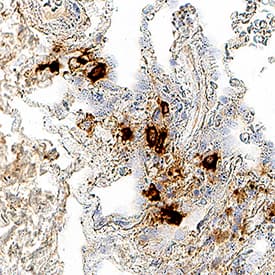Human Tryptase alpha/beta-1 Antibody
R&D Systems, part of Bio-Techne | Catalog # MAB3796

Key Product Details
Species Reactivity
Applications
Label
Antibody Source
Product Specifications
Immunogen
Ile31-Pro275
Accession # AAD13876
Specificity
Clonality
Host
Isotype
Scientific Data Images for Human Tryptase alpha/beta-1 Antibody
Detection of Tryptase alpha/beta-1 in Human Lung.
Tryptase alpha/beta-1 was detected in immersion fixed paraffin-embedded sections of Human Lung using Mouse Anti-Human Tryptase alpha/beta-1 Monoclonal Antibody (Catalog # MAB3796) at 0.1 µg/mL for 1 hour at room temperature followed by incubation with the Anti-Mouse IgG VisUCyte™ HRP Polymer Antibody (Catalog # VC001). Before incubation with the primary antibody, tissue was subjected to heat-induced epitope retrieval using VisUCyte Antigen Retrieval Reagent-Basic (Catalog # VCTS021). Tissue was stained using DAB (brown) and counterstained with hematoxylin (blue). Specific staining was localized to mast cells. View our protocol for IHC Staining with VisUCyte HRP Polymer Detection Reagents.Applications for Human Tryptase alpha/beta-1 Antibody
Immunohistochemistry
Sample: Immersion fixed paraffin-embedded sections of Human Lung
Immunoprecipitation
Sample: Conditioned cell culture medium spiked with Recombinant Human Tryptase alpha/beta-1 (Catalog # 3796‑SE), see our available Western blot detection antibodies
Western Blot
Sample: Recombinant Human Tryptase alpha/beta-1 (Catalog # 3796-SE)
Formulation, Preparation, and Storage
Purification
Reconstitution
Formulation
Shipping
Stability & Storage
- 12 months from date of receipt, -20 to -70 °C as supplied.
- 1 month, 2 to 8 °C under sterile conditions after reconstitution.
- 6 months, -20 to -70 °C under sterile conditions after reconstitution.
Background: Tryptase alpha/beta-1
Tryptases are trypsin-like serine proteases, and beta tryptases appear to be the main isoenzymes expressed in mast cells (1). They are stored in secretory granules of mast cells, where they form active tetramers with heparin proteoglycan. Because of the unique arrangement of the active sites in the tetramer, which are facing a narrow central pore, beta tryptases are resistant to macromolecule protease inhibitors (2). When mast cells are activated, beta tryptases are released along with other proteins in secretory granules, participating in provoking inflammatory conditions (3). beta tryptases have been implicated as mediators in the pathogenesis of asthma and other allergic disorders.
References
- Caughey, G. H. 2004, in Handbook of Proteolytic Enzymes, Barrett, A.J. et al. eds. pp. 1535.
- Sommerhoff, C.P. et al. (1999) Proc. Natl. Acad. Sci. USA. 96:10984.
- Hallgren, J. and G. Pejler (2006) FEBS J. 273:1871.
Alternate Names
Gene Symbol
UniProt
Additional Tryptase alpha/beta-1 Products
Product Documents for Human Tryptase alpha/beta-1 Antibody
Product Specific Notices for Human Tryptase alpha/beta-1 Antibody
For research use only
